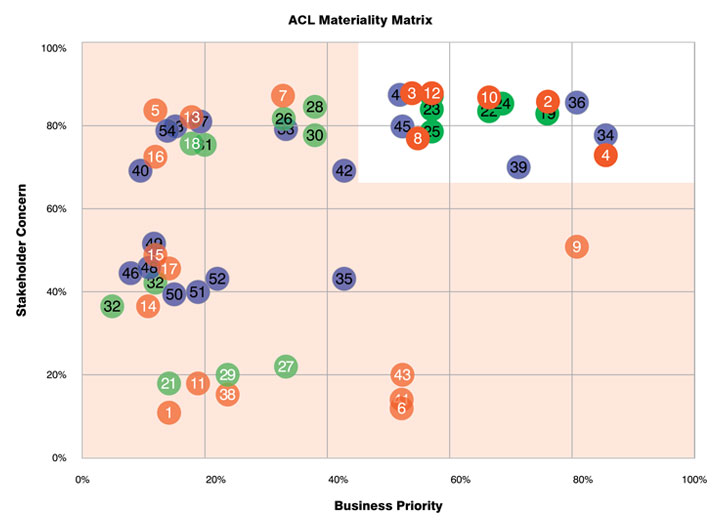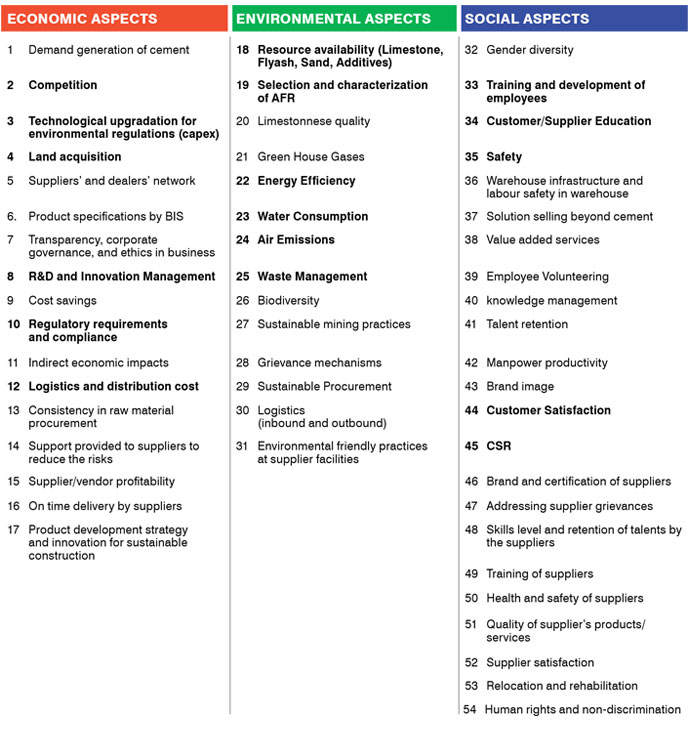Sustainability. The essence of our existence.
Report Profile, Material Aspects and Boundaries
REPORT PROFILE GRI 102-49 to 102-56
This is Ambuja Cement Limited’s 10th Corporate Sustainability Report about the Company’s continual and structured efforts towards improved disclosure of triple bottom-line performance and enriching stakeholder relationships. The annual reporting cycle covered for this report is January to December 2016. The contents of the report are in accordance with the latest requirements of the ‘GRI Standards’. Our Sustainability Performance Data, Independent Assurance Statement and the contact point for queries regarding the content in this Report are provided at the end of the Report.
The previous Sustainability Report 2015 was released in June 2016. The Report conformed to GRI G4 ‘In Accordance – Comprehensive’ criteria and was assured by a third party. The Sustainability Report is brought out in addition to the Annual Financial Report and Ambuja Cement Foundation’s Annual Report. The economic performance reported is in line with the Company’s audited annual results prepared in accordance with the Companies Act, 1956. The Company has not included subsidiaries and their performance indicators. We have a robust mechanism for reporting performance in all three areas of evaluation, i.e., economic, environmental and social. The Sustainability Report/preparation is reviewed by Top Management through Corporate Sustainability Steering Committee (CSSC) meetings. Ambuja Cement follows systems incorporated by LafargeHolcim and reports data yearly through online mechanisms or standard information carrier sheets. LafargeHolcim Accounting and Reporting Practices (LHARP) is used for all financial information; and iCare for performance on various environment, social, human resources and stakeholder aspects. There are other evaluation sheets for (i) costing and variance from the budget; (ii) occupational health and safety (OH&S) performance; (iii) energy consumption; and (iv) CO2 emission. HR-related parameters are captured in SAP.
This Report is externally assured by M/S Emergent Ventures India as per AA 1000 Assurance Standard and the Assurance Statement is a part of the Report. There is no relationship between the organisation/ employees and the assurance providers. All departments and functions concerned participated in the report assurance process.
REPORT CONTENT AND BOUNDARY GRI 102-46
Preparation of this Report has been an in-house effort led by our Corporate Environment and Sustainability team, with responses from the various departments/functions collected and considered for this purpose. The Report, including all its content, is an outcome of the combined efforts of all respondents. While we have taken due care in preparation of a comprehensive, transparent and accurate Sustainability Report, we acknowledge that we might have missed certain topics of relevance for our esteemed stakeholders. We welcome feedback and suggestions on such topics.
The aspect boundaries and content have been defined using reporting principles prescribed in the GRI Standards. While the report covers all operations and businesses of the Company that fall under its direct operational control, it excludes subsidiaries, JVs, associate companies and channel partner/dealer networks as the Company has no operational control over them. Integrated cement plants with mines, grinding plants, bulk cement terminals (offshore activities), Corporate Office and marketing offices are covered in the Report. The Company has operations only in India; all its geographical locations have been considered as one region for the reporting. The detailed financial disclosures of the Company are given in the Annual Report 2016 available on the Company website. This Report has been prepared as per GRI Standards. In designing its content, the Company followed the approach described in the GRI Standards. The material aspects that have been covered in the Report are clearly brought out in the materiality matrix. In the Report, the DMA (Disclosure on Management Approach) describes the Company’s approach to the subjects relevant to it and the indicators provide details of performance on the specific subjects.
The Company value chain includes all cement plants, bulk cement terminals, limestone mines, sales and marketing offices, channel partners, suppliers, and product design processes. There are no significant changes from the previous reporting periods in the scope and aspect boundaries and supply chain.
There were no changes in the Company ownership during the year. For all the aspects, a detailed perception study was conducted and all our key stakeholder groups have been included in the aspect boundary. GRI 102-9, 102-10
MATERIAL ASPECTS GRI 102-47
In 2015, we carried out a comprehensive stakeholder (internal and external) engagement exercise to facilitate understanding of our obligations to our stakeholders; this was consistent with our commitment towards corporate responsibility and also identified the material issues for the preparation of the GRI-based Report. It generated transparent communication, providing an opportunity for the Company to identify and address the stakeholders’ interests with respect to the operational footprint of our business. Different stakeholders found an opportunity to comment and give inputs on material issues that would directly or indirectly affect them or the Company. GRI guidelines on stakeholder engagement were followed and engagement was designed with the objective of issuebased, proactive, learning-oriented implementation to help achieve tangible outcomes in alignment with the Company’s targets. It was based on a well-defined closed loop approach inclusive of engagement strategy development, stakeholder mapping, prioritisation,

preparation and implementation of an action plan that completed the feedback loop of the system. The principles of completeness, responsiveness, transparency, collaboration, inclusiveness and integrity were addressed in alignment with Company values. The stakeholder engagement programme was deployed in phases, focusing on each identified external/ internal stakeholder group separately. Gap analysis was conducted to revise the engagement strategy and include the emerging materiality issues into its business sustainability agenda.
All material aspects are material within the organisation. The aspect boundary includes all operations of Ambuja Cements Limited but not those of its subsidiaries for which aspects are not material. Aspects are not material outside of the organisation. We acknowledge, however, that irrespective of whether or not we have direct control over certain identified material issues, we need to focus on their impact across our value chain to drive positive change towards sustainability across the value chain. There are no restatements of information provided in previous reports or any effect thereon. There are no mergers or acquisitions, or change of base years/ periods, nature of business, or measurement methods. In terms of size of the Company, there were no significant changes. GRI 102-45, 48,49, 103-1
SUSTAINABILITY ISSUES IDENTIFIED DURING THE STAKEHOLDER ENGAGEMENT
TOTAL-54, HIGH MATERIAL ASPECTS-17
